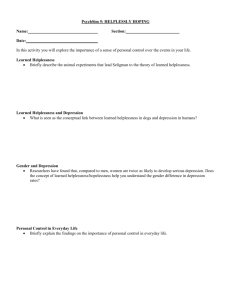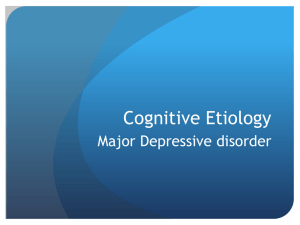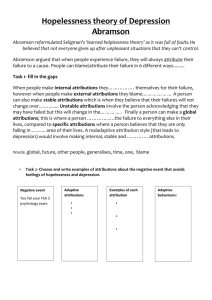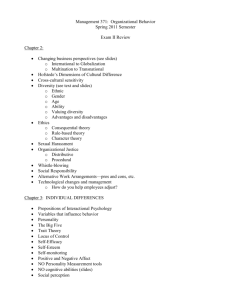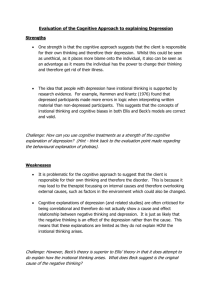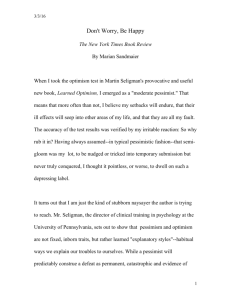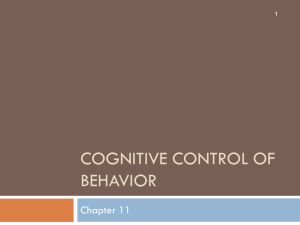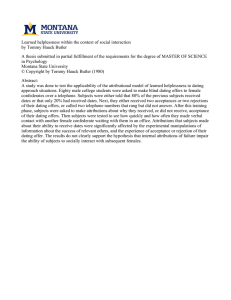Cognitive Approach to Depression: Learned Helplessness & Beck
advertisement
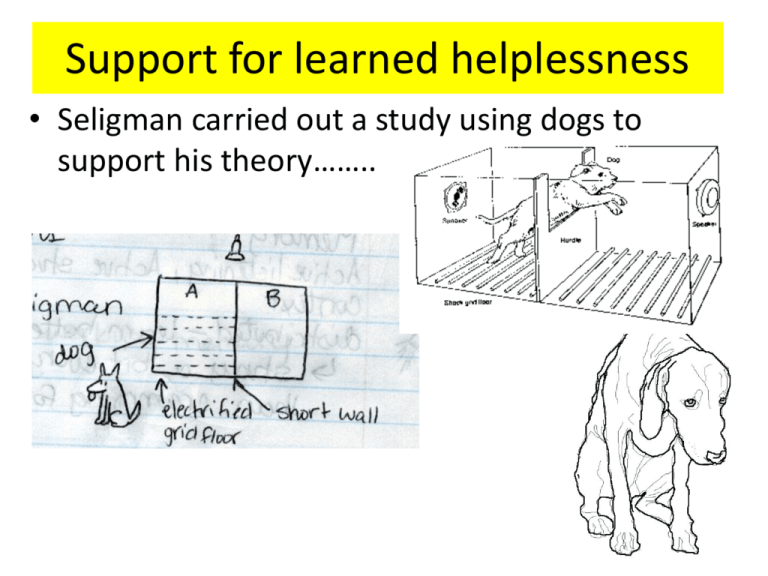
Support for learned helplessness • Seligman carried out a study using dogs to support his theory…….. More evidence from a study using humans…… Hiroto & Seligman (1974) exposed non-depressed people to a loud noise, they could a) not escape it b) stop it by pressing a button Then Ps shown a box with a handle on it. This produced a loud noise that could be stopped by moving the handle. Those in non-escape condition previously failed to move the handle. H.W Evaluation of learned helplessness theory • What is the big problem with the learned helplessness theory? • Problems with Seligmans dog experiment? • Problems with Hiroto and Seligmans human experiment? • What was good about both experiments? Cognitive Approach How does the cognitive approach explain depression? • Abramsons hopelessness theory • Becks cognitive triad Hopelessness theory of Depression Abramson Abramson reformulated Seligman's ‘learned helplessness theory’ as it was full of faults. • When people experience failure, they will always attribute their failure to a cause. • People can explain/attribute their failure in 6 different ways......... Internal External Stable Unstable Global Specific A maladaptive attribution style (that leads to depression) would involve attributing negative events to........ Internal External Stable Unstable Global Specific Task • Draw the figure below and write examples of attributions about the negative event that leads to feelings of hopelessness and depression. • Draw the figure again but write example of attributions that avoid feelings of hopelessness and depression. Negative event Attribution Internal V external Your boyfriend/girlfri Stable V unstable -end breaks up with you Global V specific Example of attributions e.g ............ e.g ............ e.g ............ Depressive Symptoms Evaluation of hopelessness theory • Support for the theory comes from studies using the ‘Attributional Style Questionnaire’ devised by Seligman • The questionnaire measures a persons attribution style • Complete questions 1-5. • Can you work out which attribution style each question is measuring? Seligman • Found that most students who performed poorly on major exams were depressed straight after they found out. • All students completed Seligman’s attributional questionnaire. • However, 2 days later, those who made external, unstable and specific attributions about their failure recovered but students who made internal, stable and global attributions remained depressed. Task – Evaluate the study Hint: • Why is the sample a problem? • What type of data was collected, and why is this a problem? Becks theory of depression • Beck was struck by the negative thinking shown by depressed people. He believed depression is the result of this negative thinking and cognitive distortions Becks Cognitive Triad Person becomes obsessed with negative thoughts and this is what leads to depression Cognitive triad is maintained by cognitive distortions (errors in thinking) • Overgeneralisations • Personalisation Making a sweeping conclusion on the basis of a single event Blaming everything on yourself • Magnification or minimisation Exaggerating or under exaggerating the significance of a event Evaluation of Beck’s theory answer the following questions……. 1.High degree of success has been achieved in treating depression with CBT. How does the success of CBT support cognitive explanations? 2. There are lots of studies to support the theory that show depressed people think more negatively than non depressed people. Can you find and outline one study using your text book. Make sure you explain how the study supports the explanation 3. But most studies are based on correlational data, why is this a problem? 4. Can you explain any other problems with the approach?
